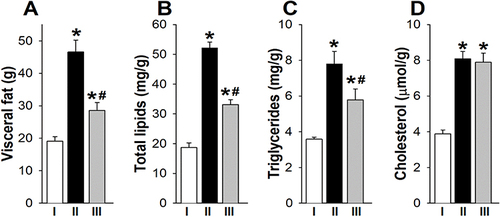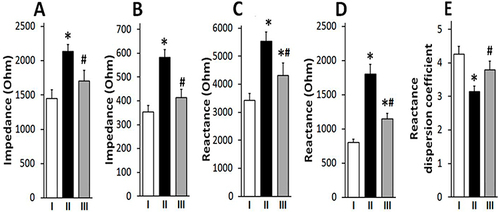Figures & data
Figure 1 The addition of L-tryptophan (80 mg/kg) to a high-calorie diet (HCD) reduced lipid metabolism disorders in the liver. L-tryptophan reduced visceral fat accumulation (A), decreased total liver lipids (B) and triglycerides (C) compared to HCD rats but had no effect on hepatic total cholesterol (D). *Different from group I at p<0.05, #Different from group II at p<0.05 (One way ANOVA followed by Bonferroni post hoc test, N=10 rats/group).

Table 1 Histomorphometric Parameters of the Liver
Figure 2 Representative images of histological slides of liver tissue ((A) Control rats, (B) Rats on high-calorie diet for 12 weeks and (C) Rats treated with L-tryptophan (80 mg/kg) in addition to high-calorie diet, Van Gieson stain, x800). 1 – mononuclear hepatocyte; 2 – binuclear hepatocyte; 3 – connective tissue cell; 4 – sinusoids; 5 – hepatocyte with numerous intracellular lipid drops; 6 – lipid drop S > 100 μm2.

Table 2 Parameters of Respiration and Oxidative Phosphorylation of Hepatocyte Mitochondria
Figure 3 L-tryptophan (80 mg/kg) prevented disturbances in the impedance and reactivity of the liver tissue. L-tryptophan reduced the high-calorie diet (HCD) induced increase in impedance on 104 Hz (A) and 106 Hz (B), and also reduced the HCD-induced increase in reactance on 104 Hz (C) and 106 Hz (D) in liver. L-tryptophan neutralized the effect of HCD on the reactivity dispersion coefficient (E) in the liver tissue (E). *Different from group I at p<0.05, #Different from group II at p<0.05 (One way ANOVA followed by Bonferroni post hoc test, N=10 rats/group).

Data Sharing Statement
The datasets used and analyzed during the current study are included in this published article.
